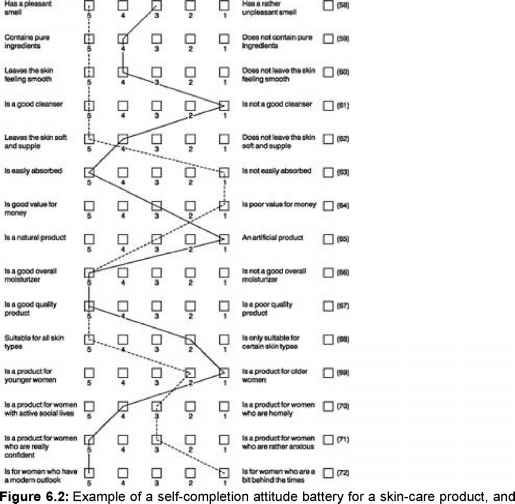Marketing Research
Formal experimental designs
These designs are research methods based on statistical principles. This means that in analysing the results not only the result of the experiment can be calculated, but also an estimate can be made of the degree of experimental error in the procedure. Formal experimental designs therefore do for market experimentation what random probability sampling does for sample selection. They allow the experimenter to calculate not only the results of the experiments, but also the probability that the...
Semantic differential scales
As their title suggests, these scales measure the difference between words. Prior research with members of the target group is undertaken to generate the 'constructs' or dimensions that people use when thinking about products and services. The semantic differential scale presents these bipolar constructs on a scale, with up to 20 scales on a page, forming an 'attitude battery'. The name of a brand at the top of the page appears, and the respondents are asked to rate that brand on each of the...
Diary panels
In the methods discussed so far it has been assumed that the research is being carried out on an ad hoc basis, i.e. a 'one-off' piece of research carried out when the decision maker has a particular need for a piece of information. However, there are situations in which it is useful to have a continuous series of measurements of the same piece of data, so that any change can be monitored. This is particularly true, for instance, when the decision maker wishes to discover what effects the...
Judgement sampling
Judgement sampling is a move further away from the unbiased attempt to provide a representative sample of the population to be surveyed. In theory, it is only the random sampling methods that do this. Quota sampling is an attempt to replicate what random sampling achieves at a lower cost, and it has some success in doing this. An element of judgement comes into the method in deciding which quota controls should be used in selection of the sample. Nevertheless, the basic aim of the method is to...
Customer relationship management systems data warehouses and data mining
The increased sophistication of computer software and hardware means that managers in even the smallest companies can have reasonably cheap access to high-powered and technical means of managing information generated by the company. An increasingly important area has been in the management of information relating to customer contact so as to improve the relationship between an organization and its customers. This is known as customer relationship management (CRM). CRM aims to produce a single...
Postal or selfcompletion questionnaires
As covered in Section 6.3, when an appropriate mailing list or easy mechanism for collecting self-completed questionnaires exists, postal or self-completion questionnaires can be a useful tool for primary data collection. This is particularly true for executives working on a small budget, or in markets where response rates are likely to be good. Industrial researchers often achieve good response rates from buyers or suppliers. Mail-order companies also use this technique to good effect....
